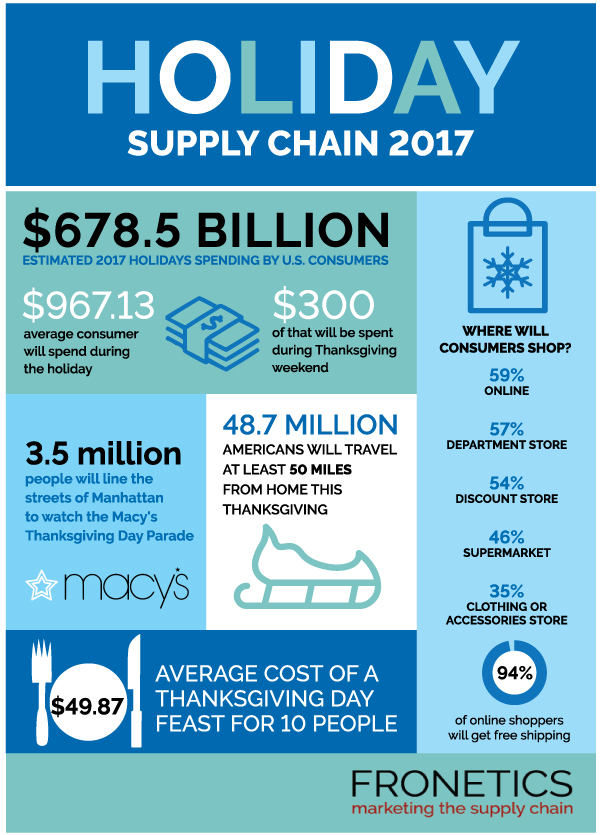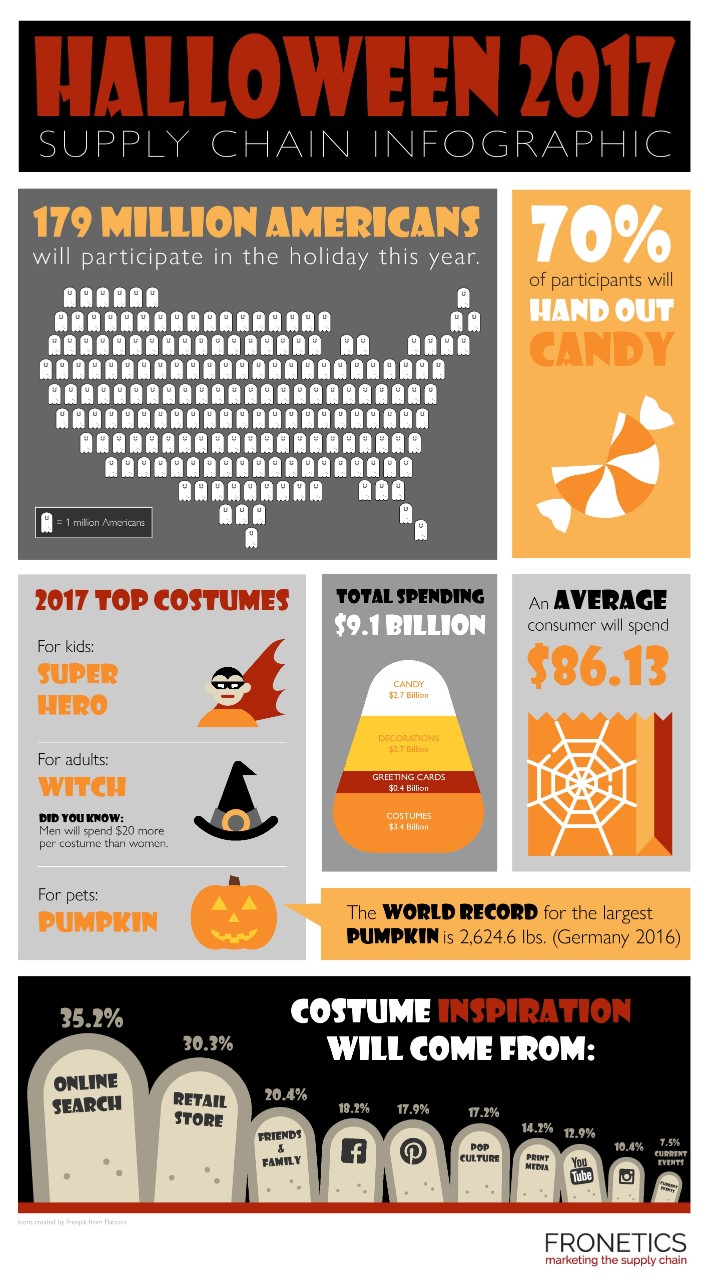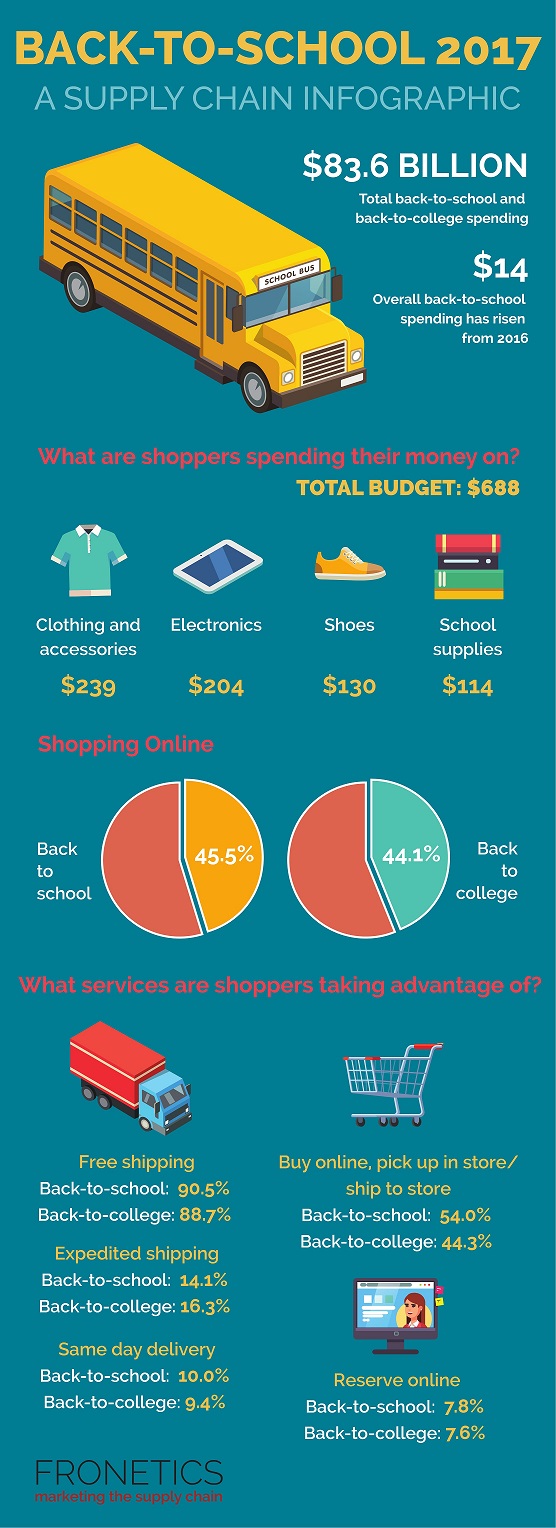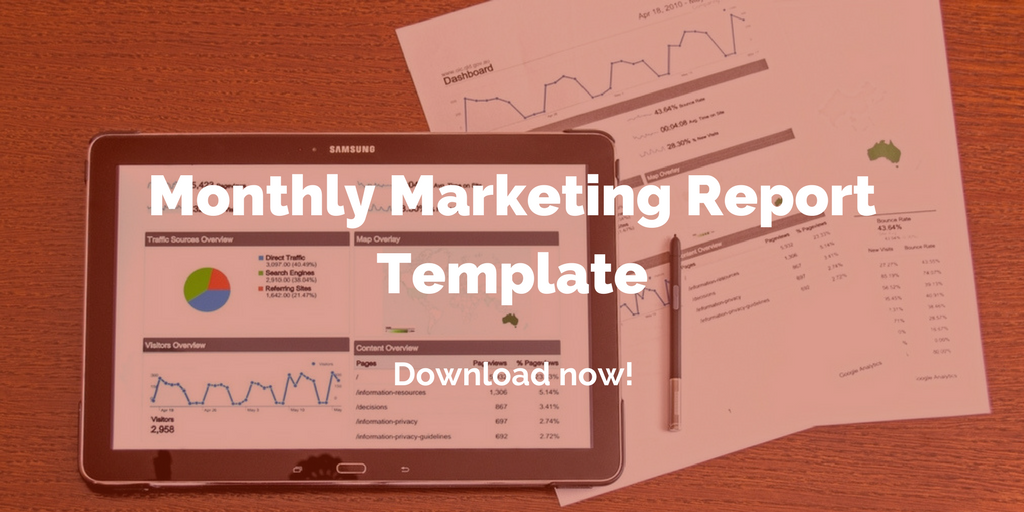
by Fronetics | Nov 16, 2017 | Blog, Current Events, Supply Chain
With the 2017 holidays right around the corner, consumers are digging into their pockets and getting ready to increase sales, especially online.
The National Retail Federation is estimating that holiday sales will be up 3.6-4% from last year, totaling $678.5 billion in holiday spending. What’s more, consumers will be hitting the malls earlier than ever. More and more retailors are forgoing the traditional Thanksgiving dinner to open their stores during the holiday. Major retailers, including Target, Kohls, and Toys “R” Us, will open their doors at 5 p.m. on Thanksgiving Day.
“[Thanksgiving] was a strong weekend for retailers, but an even better weekend for consumers, who took advantage of some really incredible deals. In fact, over one third of shoppers said 100% of their purchases were on sale,” said NRF President and CEO Matthew Shay in 2016.
The NRF is estimating that the average consumer will spend $967.13 during the holiday season, almost $300 of which will be spent during Thanksgiving weekend.
Holiday spending can be broken up into three major categories:
- Gifts
- Items such as food, decorations, flowers and greeting cards
- Other non-gift items consumers buy for themselves and their families
For the first time in NRF’s survey history, online shopping has become the most popular shopping destination. In fact, 59% of consumers will head to their computers for holiday spending, where most will benefit from free shipping (94%).
“While many consumers are holding off until November or later to start their holiday shopping, retailers should be prepared for high traffic online and in stores come Thanksgiving weekend,” Prosper Insights Principal Analyst Pam Goodfellow says. “Although sales will remain an important factor for most consumers, many will lean on convenient locations and easy-to-use websites or mobile apps along with free shipping to complete their purchases.”
2017 holidays supply chain infographic

(Made with Canva)
From all of us at Fronetics, have a wonderful Thanksgiving!
Related posts:


by Fronetics | Nov 6, 2017 | Blog, Content Marketing, Marketing
Use these four tips to earn high-quality backlinks that will boost your company’s search engine ranking.
It’s no secret that backlinks can help your search engine rankings. Backlinks are any link on another website that points (or links) back to your website. Since the 1990s, search engines have used backlinks as a bit of a popularity contest: the more you had, the more popular your website became.
It didn’t take long for companies to hunt for backlinks, creating relationships with other companies in the same industry for the sole benefit of getting links to their websites. But like all relationships, link building can be abused and, often times, only beneficial to one party. Pursuing links for search engine ranking alone creates a negative mindset, leading to uneasy relationships, damaged brand reputation, and low-quality, spammy links.
How can you achieve high-quality backlinks?
Let’s start by understanding what constitutes a high-quality backlink. SEO consultant Mark Walters defines them as links that:
- Are from a relevant and trusted source
- Have anchor text that matches your keywords
- Are on a page with Google’s PageRank
- Are next to backlinks to authority websites
- Are from different sources
- Are not reciprocal
- Are on pages with few other backlinks
Now that you know what defines a high-quality backlink, how can your company achieve these organic relationships? The answer is hard work.
Here are 4 tips to help your efforts get high-quality backlinks.
1. Create the best content available on your topic
The best content is content that is unique. Not only is original content SEO friendly, original content is audience friendly. In one minute, users share 300 hours of video on YouTube and tweet nearly 400,000 tweets times. If you want content that stands out, you need content that differs from that of the rest of the pack.
You can make content stand out by using winning headlines, graphics, images, and with great writing. Create every single piece of content with your current and prospective customers in mind. Content that attracts and engages audiences effectively communicates valuable information, providing knowledge to help guide informed decisions. Creating reliable information will establish your website and business as a thought leader within your industry, and other companies will start to take notice.
2. Perform exclusive interviews with industry experts and/or influencers
The strategy of interviewing industry experts is becoming more and more common. Here at Fronetics we often interview influencers. The draw from big names helps bring in new traffic to our site, as well as provide readers with the latest happenings in our industry.
“The benefits of creating content around authority figures in your space is vast, such as bringing recognizable authority names to your site, while also having the opportunity for such content to be shared by featured experts as well. The end result could create lots of great content for your site, while also bringing in a nice consistent supply of new traffic as well.” Writes Zac Johnson for Business 2 Community.
3. Create custom infographics
Images are a fail-safe way to create engaging content, but infographics do more than just give readers visual knowledge. Infographics also help achieve backlinks. They provide interesting and valuable information using images, giving readers the knowledge without having to read through heavy text. The most popular infographics incorporate amazing design and well-researched statistics.
According to HubSpot, social media users share and like infographics 3x more than other any other type of content. Good infographics have the ability to make your content go viral, generate tons of high-quality back-links, and improve your site’s overall SEO.
4. Participate in collaborative content marketing
Collaborative content has many benefits, but one of the biggest is reach. Your collaborators have their own followers and platforms. Combine that with your audiences, and your content is already reaching more people. These collaborations save time and money and will earn you backlinks through the other participants. Collaborative content will help drive organic traffic, provide valuable and relevant information, and introduce a new voice to your content.
Using these four strategies will help your company earn high-quality backlinks and start improving your search enginge ranking. Your higher rankings will come from organic backlinks that your hard work helped to create.
Related posts:


by Fronetics | Oct 23, 2017 | Blog, Current Events, Supply Chain
Consumers will spend a record $9.1 billion during Halloween 2017.
U.S. consumers will take to the retail markets Halloween 2017 and spend a whopping $9.1 billion on Halloween costumes, decorations, candy and more, making it the largest spending for the spooky holiday to date.
The National Retail Federation reports that consumers are preparing to be the baddest witches on the block, spending almost a billion more dollars this year on supplies than in 2016 ($8.4 billion). And the men are really stepping up their game, spending on average $20 more per costume than women.
“Americans are planning to spend more than ever as they gear up for Halloween,” NRF President and CEO Matthew Shay said. “Retailers are helping customers celebrate in style with a huge selection of costumes, candy and decorations to cater to ghosts and goblins of all ages.”
From 2017 blockbuster hits like Wonder Woman and Spiderman, it’s no wonder the most popular costumes for kids are superheroes. And let’s not forget about Fido — the most popular costume for pets for Halloween 2017 is a pumpkin.
Still need inspiration for the boo bash you’re attending? Try heading over to Instagram, a source of inspiration growing 12% year-over-year. Other consumers will get ideas from online search (35.2%), a retail store (30.3%), Facebook (18.2%), Pinterest (17.9%), and pop culture (17.2%).
Need more fun facts about Halloween to get you into the scary spirit? Check out this year’s infographic from the NRF’s survey.
Halloween 2017 supply chain infographic

(Made with Canva)
Have a safe and happy Halloween 2017, everyone!
Related posts:


by Fronetics | Aug 28, 2017 | Blog, Current Events, Supply Chain
Record spending, online shopping, and free shipping are hallmarks of back to school 2017.
With consumer confidence on the rise, the National Retail Federation predicts that back-to-college and back-to-school spending will hit $83.6 billion in 2017. That whopping total is an all-time high for back-to-college dollars, and the second highest on record for back-to-school spending, and represents and increase of more than 10% from last year.
If you started your shopping three weeks to one month before school starts, you likely found the longest lines: 46.7% of shoppers report that that’s when they planned to hit the shelves for back-to-school shopping, and 34.6% for back-to-college.
The top destinations for back-to-school shoppers are department stores (57.1%), discount stores (54.1%), and clothing stores (46.0%), while back-to-college shoppers prefer online shopping (44.1%), with discount stores (40%) and department stores (38.5%) following in second and third place. A whopping 90.5% of back-to-school shoppers plan to take advantage of free shipping services, with 88.7% doing the same for back-to-college shipping.
Per household, overall back-to-school spending has risen from last year’s average of $674 to $688 in 2017. The NRF predicts that 64% of that total will be spent on apparel and electronics.
Check out our infographic with some interesting facts from the NRF’s 2017 survey below.
Back to school 2017 supply chain infographic

(Made with Canva)
Related posts:

![What’s the Difference Between Supply Chain Management and Logistics [Infographic]](https://fronetics.com/wp-content/uploads/2024/10/Supply-Chain-Managementvs.Logistics.jpg)
by Jennifer Hart Yim | Jun 29, 2017 | Blog, Logistics, Supply Chain
Argentus’ infographic sheds light on the differences between these often-confused functions.
This guest post comes to us from Argentus Supply Chain Recruiting, a boutique recruitment firm specializing in Supply Chain Management and Procurement.
Both Logistics and the wider Supply Chain are vital to how companies run today, but the two are still so often confused. We put together an infographic outlining some of the key differences and points of overlap between them. While it may be an obvious distinction to many pros across the field, there’s still a lot of ambiguity – sometimes within companies, as well – about what constitutes Logistics, and what constitutes Supply Chain Management. As a recruitment firm with over a decade of experience specialized in this area, we figure we’d weigh in!
In short, Logistics is a part of Supply Chain Management that deals with the physical movement of goods for just in time delivery. Supply Chain, as a field, grew out of Logistics in the 80s to encompass a wider strategic consideration of everything that’s involved in bringing a product to market.
Check out the infographic below, where we dive into the topic in more detail! We’ve stepped up our game, if we do say so ourselves.
Logistics vs. Supply Chain Management

We hope you found the infographic informative! Weigh in down in the comments if there’s anything we missed, or more you have to add about the differences between these functions.
Related posts:












![What’s the Difference Between Supply Chain Management and Logistics [Infographic]](https://fronetics.com/wp-content/uploads/2024/10/Supply-Chain-Managementvs.Logistics.jpg)
